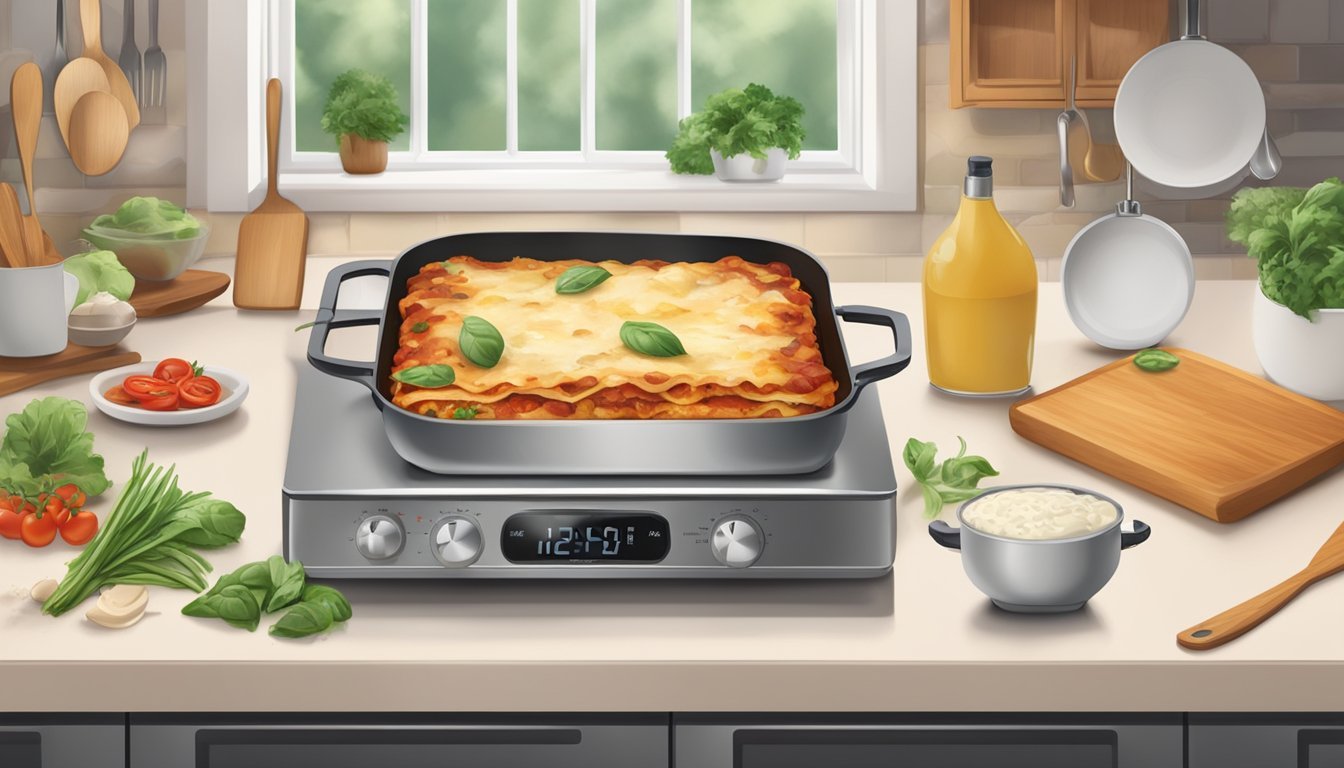How Long Does Freshly Prepared Lasagna Last?
Shelf Life and Storage Tips
Freshly prepared lasagna, with its layers of pasta, rich sauce, and melted cheese, is a beloved comfort food for many. As with any cooked dish, its freshness and safety when stored is a concern that must be addressed to ensure it can be enjoyed later. Generally, when stored properly in the refrigerator, lasagna will last for up to 5 days. Temperature control is critical, and the lasagna should be stored at or below 40°F to reduce the risk of bacterial growth.
In contrast to refrigeration, freezing extends the longevity of this dish significantly. When lasagna is frozen, its shelf life can extend to 6-8 months. The key to successful freezing lies in the method of storage. Tightly wrapping the lasagna in layers of plastic wrap, foil, and a final covering of plastic wrap, before labeling and dating ensures that the lasagna remains protected from freezer burn and flavor loss.
Consumers should take care to reheat previously stored lasagna to an internal temperature of 165°F before consuming, regardless of whether it has been stored in the refrigerator or freezer. This step is crucial for food safety as it ensures the elimination of harmful bacteria that may have multiplied. These guidelines for storing and reheating lasagna help maintain its quality and safety for future enjoyment.
Understanding Lasagna Components
A precise understanding of lasagna components is crucial to assess how the flavors, textures, and quality of this beloved dish are affected over time. Different types of pasta, cheeses, and fillings each play a pivotal role in the overall integrity and longevity of lasagna.
Noodle Composition
Lasagna noodles serve as the structural base that holds the layers together. Homemade lasagna often features fresh pasta, which can contribute to a more delicate texture. For optimal consistency, noodles are typically cooked to be al dente before layering, ensuring they maintain their form and do not become too soft during the baking process. The choice of noodles can influence not only the flavor but also how well the lasagna will hold up during storage.
Various Fillings and Layers
The fillings and layers of lasagna contribute to the depth of flavor and are a significant factor in its shelf life. Ingredients can range from meat sauce with beef, pork, or chicken, to an assortment of vegetables like spinach, zucchini, and eggplant. (What wine goes well with eggplant?) Each ingredient should be considered for its moisture content and how it may affect the lasagna's structure over time. Cheeses such as ricotta, mozzarella, and parmesan are also integral for both texture and flavor, with the potential to impact the dish's freshness.
Types of Lasagna
Different versions of lasagna, such as the classic meat-based, vegetarian, or even vegan alternatives, offer various shelf lives. A typical meat lasagna might feature a tomato sauce base, enriched with onions and garlic, while a vegetarian variant could focus on layering vegetables and cheeses like ricotta and mozzarella. The components chosen will not only dictate the immediate taste and consistency but also how well a cooked lasagna or uncooked lasagna withstands freezing and subsequent reheating.
Storage Fundamentals
Appropriate storage of lasagna is critical to maintaining its freshness and ensuring food safety. The shelf life varies significantly based on how the lasagna is stored.
Short-Term Fridge Storage
Freshly prepared lasagna can be stored in the fridge for up to 3-4 days. It should be cooled to room temperature to prevent moisture buildup and then wrapped with plastic wrap or aluminum foil. For added protection against contaminants and to ensure moisture retention, use an airtight container.
Cool: Room temperature to prevent condensation inside the packaging.
Wrap: Plastic wrap or aluminum foil.
Container: An airtight container for additional protection.
Fridge Placement: Place in the casserole or coldest part of the fridge.
Freezing and Long-Term Storage
For extending the shelf life, freeze lasagna either whole or in portions. Use freezer bags, airtight containers, or wrap it with freezer wrap. Properly stored, lasagna can last in the freezer for 6-8 months. Thaw in the fridge for 24 hours before reheating. Labeling with the freeze date helps track how long it has been stored.
Wrap/Container: Choose freezer bags, airtight containers, or freezer wrap.
Freeze Duration: 6-8 months.
Thawing: 24 hours in the fridge.
Label: Clearly mark with the freeze date.
General Storage Tips
To preserve the best quality of your lasagna:
Prevent freezer burn by ensuring it's wrapped tightly and securely.
To avoid flavor loss and textural changes, keep storage times within recommended periods.
Consider portioning lasagna before storing to make thawing and reheating more convenient.
Safe Food Handling Practices
Food safety is paramount when storing any type of meal, including lasagna. Maintain a consistent temperature control to avoid the growth of bacteria that can lead to foodborne illness.
Temperature: Keep your fridge below 40°F and your freezer at or below 0°F.
Cross-Contamination: Store lasagna away from raw foods, especially meats, to avoid cross-contamination.
Reheating: When reheating, ensure the internal temperature reaches 165°F to kill any potential bacteria.
Optimal Lasagna Lifespan
The lifespan of freshly prepared lasagna primarily depends on the storage method. Refrigeration typically allows for 3 to 5 days of freshness, while freezing can extend this period significantly.
Refrigeration and Freshness
When stored in the refrigerator, cooked lasagna should be placed in an airtight container or tightly wrapped to maintain quality. It is generally safe to consume for 3 to 5 days. To ensure safety, the lasagna should be kept at or below 40°F (4°C), which inhibits the growth of harmful bacteria.
Freezing and Defrosting
Freezing lasagna can prolong its shelf life, making it safe to eat for up to 2 months. Lasagna should be frozen in covered airtight containers, heavy-duty freezer bags, or wrapped tightly in aluminum foil. When thawing, it is recommended to transfer the lasagna to the refrigerator and allow it to thaw gradually. To maintain safety and quality, once thawed, consume the lasagna within 3 to 5 days.
Signs of Spoilage
Spoilage in lasagna can be identified by visual cues and off odors. Discard any lasagna that shows signs of:
Mold growth
Unpleasant or sour smell
Discoloration or slimy texture
Consuming spoiled lasagna poses a risk of foodborne illness, so it is crucial to examine the dish before consuming and discard anything that seems compromised in terms of freshness or appearance.
Preparation and Consumption
Proper preparation and consumption methods are crucial for maintaining the safety and taste of freshly prepared lasagna. This section provides specific guidelines on preparing lasagna safely, reheating leftovers while preserving quality, serving it safely, and storing it appropriately after consumption.
Safe Preparation Procedures
When preparing lasagna, one should always follow food safety principles to prevent foodborne illnesses. Lasagna should be baked at a minimum temperature of 165°F to ensure it is safe to eat. It is beneficial to use separate utensils and cutting boards for raw ingredients to avoid cross-contamination.
Before Baking:
Assemble lasagna in a clean, sanitized area.
Ensure all ingredients are cooked to their proper temperatures before layering.
During Assembly:
Use clean utensils for each ingredient.
Layer components cautiously to prevent ingredients from spilling and contaminating the workspace.
Reheating for Best Quality
To maintain the lasagna's texture and flavor when reheating, it should be warmed thoroughly to a temperature of 165°F. The oven is preferred for keeping the layers intact and the cheese melted evenly.
Oven Reheating:
Preheat the oven to 350°F.
Cover lasagna with foil to prevent drying.
Microwave Reheating:
Place a serving of lasagna in a microwave-safe dish.
Use a microwave cover or a suitable lid to retain moisture and provide even heating.
Serving Safely
Lasagna should be served hot and consumed within a reasonable period after preparation to ensure it remains safe to eat. Leftovers should be managed efficiently to avoid the risk of food poisoning.
Temperature Control:
Serve lasagna above 140°F to keep it in a safe temperature zone.
Do not leave lasagna at room temperature for more than 2 hours.
Post-Consume Storage
Properly storing leftover lasagna is essential for preserving its quality and preventing spoilage. Leftovers should be cooled down and transferred into an airtight container before being placed in the refrigerator or freezer.
Airtight Storage:
Store in shallow airtight containers to cool faster and evenly.
Label the container with the storage date.
Refrigeration and Freezing:
Refrigerate leftover lasagna within two hours of serving to limit bacterial growth.
For longer storage, freeze lasagna by wrapping it securely to avoid freezer burn.
Maximizing Lasagna Enjoyment
To fully appreciate lasagna, understanding how to maintain its flavor and texture is essential, as well as exploring creative ways to enjoy leftovers. The ingredients in lasagna not only contribute to its taste but also offer various health benefits.
Getting the Best Flavor and Texture
Lasagna’s quality is heavily dependent on its flavor and texture, which are maximized by using fresh, high-quality ingredients. Layering the lasagna properly can prevent sogginess; dry noodles and an even spread of ricotta cheese and meat sauce contribute to a firm yet tender texture. To avoid a dry-out effect or a runny texture upon reheating, one should:
If Cooling If Freezing Cover with foil or plastic wrap Wrap in airtight packaging Store in the fridge for up to 5 days Freeze for 2-3 months
Reheat gently, in microwave-safe dishes, stirring occasionally to ensure even heating.
Creative Leftovers Ideas
Leftover lasagna can be repurposed to keep mealtimes interesting. A single serving of lasagna can be cubed and used as a filling for stuffed bell peppers (What wine goes well with stuffed bell peppers?) or rolled into a lasagna casserole burrito. Leftovers may also be layered with additional cheese and vegetables like spinach, zucchini, or eggplant to create a new lasagna-like dish.
Health Benefits of Lasagna Ingredients
Lasagna houses a myriad of ingredients that can bolster one’s nutrition. The cheese, including ricotta, provides calcium and protein, while the meat sauce is a source of iron and protein. The inclusion of vegetables like spinach, zucchini, eggplant, onions, and garlic not only enhances flavor but also offers vitamins, minerals, and fiber, essential for maintaining good health. When balanced with whole grain noodles or additional vegetables, lasagna can be a hearty, nutritious meal option.
Final Thoughts
When storing lasagna, maintaining its quality and ensuring food safety are paramount. Lasagna's longevity depends on proper storage techniques. In the fridge, one should store it with care, typically for up to five days. It is advisable to cover the lasagna with foil or plastic wrap to prevent it from drying out or absorbing other food flavors.
Freezing Lasagna:
Wrap tightly with plastic wrap.
Add a layer of aluminum foil for extra protection.
Label with the date for future reference.
To freeze lasagna effectively, wrapping it in a double layer of plastic wrap followed by foil can preserve it for up to three months. Freezing not only extends the shelf life but also locks in flavor. When one is ready to enjoy the frozen lasagna, it's crucial to thaw it properly in the refrigerator before reheating to ensure even warming and to maintain the dish's integrity.
Reheating Lasagna:
Thaw in the refrigerator if frozen.
Reheat in an oven until it reaches an internal temperature of 165°F.
Reheated lasagna should be brought to an internal temperature of 165°F to guarantee food safety, and one should consume it immediately after reheating. Continuous reheating can diminish the dish’s quality and may increase the risk of spoilage. Remembering these key points ensures one enjoys lasagna at its best while minimizing food waste.
Frequently Asked Questions
In this section, readers will find concise answers regarding the stability of lasagna when left out, the implications of freezing lasagna with specific cheese content, and tips for effectively labeling lasagna prior to freezing for optimal use.
Does Lasagna Go Bad if Left Out Overnight?
Lasagna should not be left out at room temperature for more than 2 hours. Beyond this period, bacteria can grow rapidly, making it unsafe to eat. If lasagna has been left out overnight, it is advisable to discard it to prevent foodborne illness.
Can You Freeze Lasagna With Ricotta Cheese?
Freezing lasagna with ricotta cheese is feasible and can extend its shelf life. The texture of ricotta, once frozen and thawed, may slightly change, but it will remain tasty and safe for consumption. When freezing, ensure the lasagna is stored in an airtight container or tightly wrapped to prevent freezer burn, and it can last up to 3 months.
How to Label Frozen Lasagna for Best Use
Labeling frozen lasagna is crucial for maintaining quality and safety. Use these guidelines for labeling:
Date of Freezing: Write the freeze date to track how long the lasagna has been stored.
Contents: List the key ingredients, especially if you have variations with different fillings or if allergies are a concern.
Reheating Instructions: Note the preferred oven temperature and cooking time for convenience.
Use a permanent marker to ensure the label remains legible throughout storage.
References and Additional Resources
When discussing lasagna’s shelf life, storage, and quality, several respected sources offer valuable insights.
Eat By Date: Provides detailed timelines for both frozen and refrigerated lasagna, emphasizing the importance of proper storage.
Chef’s Resource: Offers guidelines for refrigerating lasagna, stressing the need for airtight containers or tightly wrapped plastic to maintain freshness.
Food Safety: Suggests critical food safety practices when handling, storing, and preparing lasagna to prevent spoilage.
For those looking to freeze lasagna:
It is generally recommended to wrap lasagna tightly and store it for up to three months.
In terms of reheating:
Proper methods to reheat lasagna while retaining its quality and ensuring it is heated to a safe temperature are critical.
Entity Resource Storage Chef's Resource Freeze Eat By Date, Chef's Resource Shelf Life Eat By Date Spoil Food Safety, Chef's Resource Reheat Food Safety Safety and Quality All resources cover aspects of this topic.
For accurate, up-to-date information regarding how long does lasagna last, and maintaining food safety, readers may visit these sources to enhance their understanding and ensure that their lasagna remains both delicious and safe to eat.








